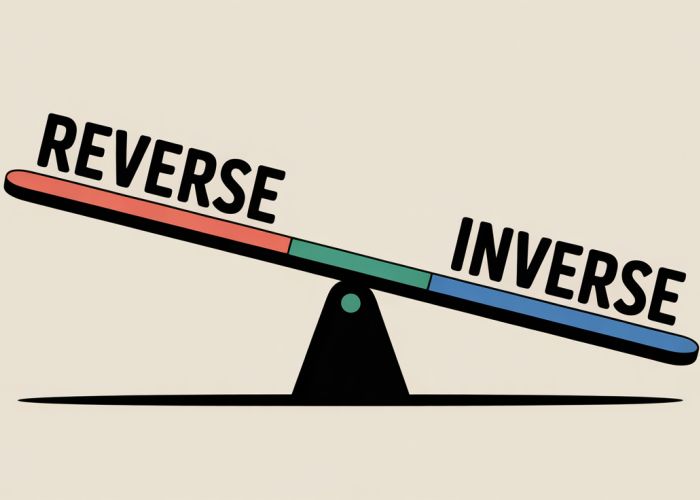Mathematical functions exhibit various properties, and understanding these is crucial. Operations within fields like linear algebra are commonly described using concepts of reversing or inverting. A deep dive into set theory helps clarify the subtle, yet critical, distinctions between reverse vs inverse operations, especially within diverse fields of research such as computer science where code execution often necessitates careful consideration of these differences.

Reverse vs Inverse: Decoding the Difference
Understanding the nuances between "reverse" and "inverse" can be tricky, especially since they’re often used interchangeably in everyday language. However, in mathematics, computer science, and other technical fields, they represent distinct concepts. This article will dissect the differences between "reverse" and "inverse" to provide a clear and comprehensive understanding.
Defining "Reverse"
"Reverse" generally implies an alteration in the order or sequence of elements within a set, list, or process. The original components remain the same, but their arrangement is flipped or inverted.
Reversing a Sequence
-
The core idea is to change the order, not the elements themselves.
-
Common examples include reversing a string of characters or a list of numbers.
Example: The reverse of the string "hello" is "olleh". The elements (letters) are the same, but their sequence is flipped.
-
Reversal is typically applied to ordered collections.
Reversing a Process
-
In the context of a process, "reversing" often means retracing the steps in the opposite order they were initially performed.
Example: If you built a tower block by block, reversing the process means taking it apart block by block, in the reverse order you placed them.
Defining "Inverse"
"Inverse", in contrast to "reverse", signifies an operation that undoes the effect of another operation, typically in a mathematical or logical context. It is about finding the counterpart that neutralizes or cancels out the original action.
Inverse Operations in Mathematics
- Addition and Subtraction: Subtraction is the inverse operation of addition. If you add 5 to 3 to get 8, subtracting 5 from 8 gets you back to 3.
- Multiplication and Division: Division is the inverse operation of multiplication. If you multiply 4 by 2 to get 8, dividing 8 by 2 gets you back to 4.
- Functions: The inverse of a function, denoted as f⁻¹(x), "undoes" what the function f(x) does. If f(x) = 2x, then f⁻¹(x) = x/2.
Inverse Matrices
- In linear algebra, an inverse matrix (A⁻¹) is a matrix that, when multiplied by the original matrix (A), results in the identity matrix (I). This is a crucial concept in solving systems of linear equations.
Key Differences Summarized: A Comparison Table
To further illustrate the "reverse vs inverse" distinction, consider this table:
| Feature | Reverse | Inverse |
|---|---|---|
| Core Concept | Change in order or sequence | Operation that undoes another operation |
| Element Change | Elements remain the same | Elements might be transformed or replaced |
| Applicability | Sequences, processes, lists, strings | Mathematical operations, functions, matrices, logic |
| Purpose | Invert the order | Neutralize or cancel out the original action |
Examples to Solidify Understanding
Reversing a List vs. Finding the Inverse of a Matrix
Consider the list [1, 2, 3, 4]. Reversing this list results in [4, 3, 2, 1]. The numbers remain the same, but their order has changed.
Now, imagine a 2×2 matrix:
A = | 2 1 |
| 3 4 |
Finding the inverse of this matrix (A⁻¹) involves a specific mathematical procedure, ultimately resulting in a new matrix:
A⁻¹ = | 0.8 -0.2 |
| -0.6 0.4 |
Multiplying A by A⁻¹ would yield the identity matrix. Note that the elements in A⁻¹ are different from those in A, demonstrating the transformative nature of the inverse operation.
Reversing Directions vs. Inverse Trigonometric Functions
If you are driving and you "reverse directions", you turn around and head back the way you came. You follow the same path in the opposite order.
In contrast, inverse trigonometric functions like arcsin(x) or arccos(x) do not involve "reversing directions". Instead, they provide the angle whose sine or cosine is x, respectively. They perform a fundamentally different operation than finding the reverse direction.
Reverse vs Inverse: FAQs
Here are some frequently asked questions to further clarify the difference between reverse and inverse functions.
What’s the core distinction between reversing and inverting a function?
Reversing a function typically changes the order of elements within its output, like flipping a list. In contrast, finding the inverse of a function undoes the original function’s action; it maps the output back to its original input. Understanding this "undoing" is key to the reverse vs inverse concept.
How do I determine if a function has an inverse?
A function has an inverse only if it’s bijective, meaning it’s both injective (one-to-one) and surjective (onto). Essentially, each output must correspond to a unique input for the inverse to exist. The act of reversing a function, on the other hand, is always doable if the function produces ordered data.
Can you give a simple example to illustrate reverse vs inverse?
Consider the function f(x) = 2x. The inverse is f⁻¹(x) = x/2, which undoes the multiplication. If we had data [1, 2, 3] and applied f(x), we get [2, 4, 6]. Reversing that output gives us [6, 4, 2], while applying the inverse, f⁻¹(x), would give [1,2,3] – or the original input.
When is understanding the reverse vs inverse difference most important?
The distinction matters particularly in areas like cryptography, data manipulation, and signal processing. Using an inverse function provides the way to recover original data whereas reversing provides reordered data. Knowing which operation to apply is crucial for achieving the desired outcome, whether it’s decryption or simply reordering a list.
So there you have it! Hopefully, you’ve got a much clearer idea about reverse vs inverse and how to use them properly. Go forth and apply that knowledge!